Click on images to enlarge
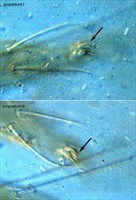
Fig. 1. Tetranychus lambi adult female paratype from strawberry - detail of empodium I (arrows indicate minute dorsal spur).
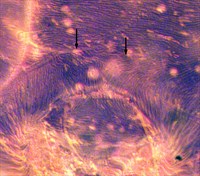
Fig. 2. Tetranychus lambi adult female paratype from apple (same data as holotype) - detail of pattern of pregenital striae (n.b. specimen not cleared; arrows indicate striae).
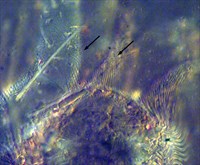
Fig. 3. Tetranychus lambi adult female paratype from apple (same data as holotype) - detail of pattern of pregenital striae (n.b. specimen not flat; arrows indicate regions in focus, with longitudinal striae).
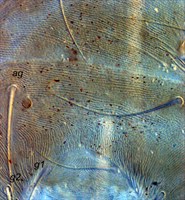
Fig. 4. Tetranychus lambi adult female paratype from strawberry (data different to holotype) - detail of pattern of pregenital striae.
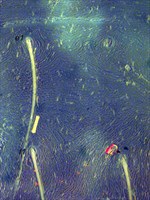
Fig. 5. Tetranychus lambi adult female paratype from apple (same data as holotype) - detail of pattern of dorsal striae between setae e1 and f1 - more or less transverse between e1-e1 and e1-f1, and striae longitudinal between f1-f1.
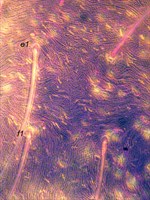
Fig. 6. Tetranychus lambi adult female paratype from apple (same data as holotype) - detail of pattern of dorsal striae between setae e1 and f1 - irregular between e1-e1, transverse e1-f1, longitudinal between f1-f1 (n.b. specimen not expanded, and not cleared).
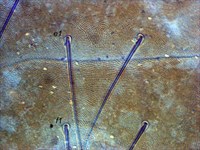
Fig. 7. Tetranychus lambi adult female paratype from strawberry (different data to holotype) - detail of pattern of dorsal striae between setae e1 and f1 - longitudinal between e1-e1, transverse e1-f1, longitudinal between f1-f1.
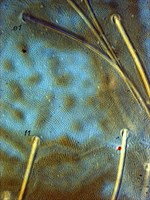
Fig. 8. Tetranychus lambi adult female paratype from strawberry (different data to holotype) - detail of pattern of dorsal striae between setae e1 and f1 - longitudinal between e1-e1, transverse e1-f1, longitudinal between f1-f1.
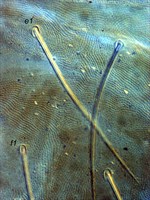
Fig. 9. Tetranychus lambi adult female paratype from strawberry (different data to holotype) - detail of pattern of dorsal striae between setae e1 and f1 - longitudinal between e1-e1, transverse e1-f1, longitudinal between f1-f1.
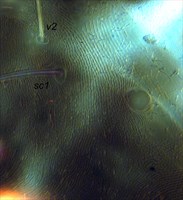
Fig. 10. Tetranychus lambi adult female paratype from apple (same data as holotype) - detail of pattern of prodorsal striae, with large lobes.
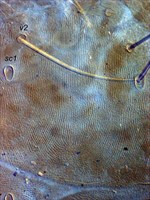
Fig. 11. Tetranychus lambi adult female paratype from strawberry (data different to holotype) - detail of pattern of prodorsal striae.
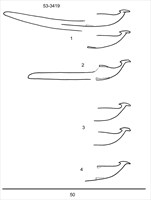
Fig. 12. Tetranychus lambi adult males from apple (all with same data as holotype), detail of aedeagus (at different focal points) - 1, 2 paratypes; 3, 4 non-types.
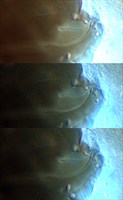
Fig. 13. Tetranychus lambi adult male paratype from apple (same data as holotype) - detail of aedeagus (at different focal points).
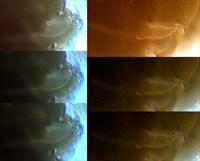
Fig. 14. Tetranychus lambi adult male paratypes from apple (same data as holotype) - detail of aedeagus (at different focal points).

Fig. 15. Tetranychus lambi adult male paratype from apple (same data as holotype) - detail of aedeagus (at different focal points).
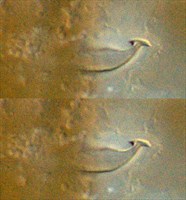
Fig. 16. Tetranychus lambi adult male from apple (same data as holotype) - detail of aedeagus (at different focal points).
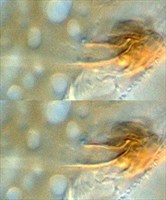
Fig. 17. Tetranychus lambi adult male from apple (same data as holotype) - detail of aedeagus (at different focal points).

Fig. 18. Tetranychus lambi adult male paratypes, detail of aedeagus (at different focal points) - a. from strawberry (different data to holotype); b.c., from apple (same data as holotype).
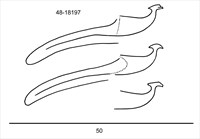
Fig. 19. Tetranychus lambi adult male paratype from strawberry (different data to holotype) - detail of aedeagus (at different focal points).
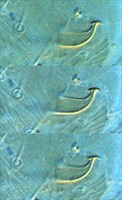
Fig. 20. Tetranychus lambi adult male paratype from strawberry (different data to holotype) - detail of aedeagus (at different focal points).
Material examined
paratypes; non-types
Taxonomy
Subfamily Tetranychinae
Tribe Tetranychini
Common Name
-
Strawberry spider mite
-
Banana spider mite
Distribution
+Australia, American Samoa, Cook Islands, Fiji, French Polynesia, Iran, New Caledonia, *New Zealand, Papua New Guinea, Taiwan, Tonga, Vanuatu, Wallis & Futuna, Western Samoa
Taxonomy Changes
Tetranychus lambi Pritchard & Baker 1955
Tetranychus cordylinicolus Lo 1969, synonymy Tseng 1990
Diagnosis
Female - apple (see Notes)
- empodia I-IV without dorsal spur above proximoventral hairs
- tarsus I with the sockets of four tactile setae proximal to, and one solenidion overlapping, the socket of proximal duplex seta
- tarsus II with the sockets of three tactile setae and one solenidion proximal to, and socket of one tactile seta overlapping, the socket of the duplex seta
- pregential striae longitudinal, sometimes wavy/irregular, sometimes with lobes apparent (Figs 2, 3)
- peritreme with short recurved hook
- striae on prodorsum with large lobes (Fig. 10)
- dorsal striae between setae e1-f1 not forming a diamond (= "hourglass") - striae between e1-e1 more or less transverse (Fig. 5) (can be irregular, Fig. 6), e1-f1 transverse, f1-f1 longitudinal (Figs 5, 6)
Female - strawberry (see Notes)
- empodia I-IV with dorsal spur above proximoventral hairs minute or absent (Fig. 1)
- tarsus I-II proximal setae the same as apple specimens
- pregential striae longitudinal (Fig. 4)
- peritreme with short recurved hook
- striae on prodorsum with small lobes (Fig. 11)
- dorsal striae between setae e1-f1 forming a diamond pattern - striae between e1-e1 longitudinal (can be somewhat irregular (Fig. 8), e1-f1 transverse, f1-f1 longitudinal (Figs 6-8)
Male - apple
- empodia I-IV with no dorsal spur above proximoventral hairs
- empodium I with proximoventral hairs fused to form claw
- tarsus I with the sockets of four tactile setae and two solenidia proximal to, and one solenidion overlapping, the socket of the proximal duplex seta
- tarsus II with sockets of three tactile setae and one solenidion proximal to, and one tactile seta overlapping, the socket of the duplex seta
- aedeagus directed dorsally, with short neck and distinct knob; anterior projection of knob short sharp triangular; posterior projection narrow rectangular, parallel with dorsal margin of shaft (posterior tip of rectangle can appear to be tapered to form ventrally directed point - see specimens 2 and 3, Fig. 12; Fig. 16); dorsal margin of knob weakly convex to straight, parallel with dorsal margin of shaft; dorsal margin of shaft parallel with ventral margin of shaft; ventral margin of shaft more or less straight (Figs 12-18)
Male - strawberry
- empodia I-IV and tarsus I-II the same as apple specimens
- aedeagus directed dorsally, with short narrow neck and distinct knob; anterior projection of knob short broad triangular; posterior projection varies with focal point from broad rectangle abruptly narrowed forming short truncate projection, to ventrally curved narrow triangular projection, to ventrally directed tapering truncate projection; dorsal margin of knob likewise varies with focal point from angled dorsally at 20° with abrupt ventral bend, to strongly convex; dorsal margin of shaft at 5° angle to ventral margin of shaft; ventral margin of shaft straight to weakly convex (Figs 18-20)
Hosts
> 60 host plant species, including: Abelmoschus manihot, Abutilon tubulosum (Malvaceae), Alocasia macrorhiza (Araceae), Arachis hypogaea (Fabaceae), Arenga engleri (Arecaceae), Carica papaya (Caricaceae), Centrosema plumieri (Fabaceae), Chloris gayana (Poaceae), Cocos nucifera (Arecaceae), Cucurbita maxima, C. pepo (Curcurbitaceae), Desmodium intortum, D. uncinatum (Fabaceae), *Fragaria vesca (Rosaceae), Glycine max, G. tomentosa (Fabaceae), Goodenia ovata (Goodeniaceae), Gossypium hirsutum (Malvaceae), *Malus domestica (Rosaceae), Manihot esculenta (Euphorbiaceae), Morus alba (Moraceae), Musa sapientum (Musaceae), Nicotiana tabacum (Solanaceae), Oxalis latifolia (Oxalidaceae), Panicum maximum (Poaceae), Phaseolus caracalla, P. vulgaris (Fabaceae), Prunus persica (Rosaceae), Quercus alba (Fagaceae), Setaria italica (Poaceae), Sida rhombifolia (Malvaceae), Solanum melongena (Solanaceae), Stephania japonica (Menispermaceae), Stylosanthes guianensis, Teramnus uncinatus, T. volubilis, Trifolium pratense, Tr. repens, Vicia sp. (Fabaceae), Xanthosoma sagittifolium (Araceae)
Biology
Like most species of spider mite, feeding by Tetranychus lambi causes flecking and mottling of leaves. The mite can also infect fruit, causing extensive brown skin blemishes and consequent loss of market value. This species is of significant economic importance on strawberries and bananas, and an occasional pest on other crops. Damage is usually worst in dry weather in spring, summer and early autumn, whereas damage to fruit trees is commonly seen in late winter.
This species is small compared to other species found in Australia. Females are green or yellowish with dark spots along each side of the body.
References
Bolland, H.R., Gutierrez, J. and Flechtmann, C.H.W. (1998) World catalogue of the spider mite family (Acari: Tetranychidae). Brill Academic Publishers, Leiden, 392 pp.
+Davis, J.J. (1968a) Studies of Queensland Tetranychidae. 3. Records of the genus Tetranychus. Queensland Journal of Agricultural and Animal Sciences 25: 57-67
Flechtmann, C.H.W. and Knihinicki, D.K. (2002) New species and new record of Tetranychus Dufour from Australia, with a key to the major groups in this genus based on females. Australian Journal of Entomology 41: 118-127
+Gutierrez, J. and Schicha, E. (1983) The spider mite family Tetranychidae (Acari) in New South Wales. International Journal of Acarology 9: 99-116
Hassan, E.A. (1977) Major insect and mite pests of Australian crops. Gatton, Queensland: Ento Press.
Jeppson, L.R., Keifer, H.H. and Baker, E.W. (1975) Mites injurious to Economic Plants. Berkely: University of Californai Press.
Lo, P.K.C. (1969) Tetranychoid mites infesting special crops in Taiwan. Bull. Sun Yat-Sen Cult. Found. 4: 43-82
Migeon, A. and Dorkeld, F. (2006-2017) Spider Mites Web: a comprehensive database for the Tetranychidae. http://www.montpellier.inra.fr/CBGP/spmweb
+Miller, L.W. (1966) The tetranychid mites of Tasmania. Papers and Proceedings of the Royal Society of Tasmania 100: 53-76
*Pritchard, A.E. and Baker, E.W. (1955) A revision of the spider mite family Tetranychidae. Pacific Coast Entomological Society, Memoirs Series Vol 2 :1-472
Tseng, Y .H. (1990) A monograpph of the mite family Tetranychidae (Acarina: Trombidiformes) from Taiwan. Taiwan Museum Special Publications, Series 9, Taipei, Rep. China :1-226
Notes
Several paratypes and non-types with the same data as the holotype were examined, along with several paratypes with different collection data to the holotype. The holotype was collected from apple, and the paratype series includes specimens from apple and from strawberry. The specimens from strawberry are morphologically different to those from apple and could possibly represent a separate (and as yet undescribed) species.
Due to there possibly being two different taxa in the type series, in the literature there is considerable confusion over the exact pattern of the striae between dorsal setae e1 and f1. Pritchard & Baker (1955) say the striae between setae f1-f1 are longitudinal, and the striae between setae e1-f1 form an hourglass pattern. Jeppson et al. (1975) say the pattern between setae e1-f1 is a diamond. Flechtmann & Knihinicki (2002) say the species has entirely transverse striae. The dorsal striae on specimens examined during this study, from New Zealand and Queensland and some specimens from Tasmania form a diamond shape between setae e1-f1. There are, however, exceptional specimens from Tasmania, from Goodenia (Goodeniaceae), that have an hourglass pattern. Thus it could be that there are several species all being called T. lambi, and this is causing the confusion about the true characters for the species. Alternatively, sometimes the striae between setae e1-e1 and f1-f1 are sometimes oblique rather than truly longitudinal, and this may create confusion for identifiers.
Copyright © 2018. All rights reserved.